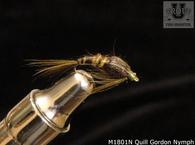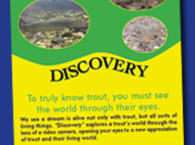The Quill Gordons (Eperous Pleuralis) nymphs are clingers. For most of their life,
up until it is near the time for them to hatch, they stay hidden down between and
under the rocks on the bottom of the fast water runs and riffles. They are not
readily available for trout to eat. A few days before they begin to hatch they move
from their fast water habitat to slower moving water. Often this is behind large rocks
and boulders near the fast water. Trout are very aware of this short migration of the
nymphs and take advantage of them during this time when it is very easy for them
to do so.
If they are not eaten by trout, the nymphs remain there until they are ready to
hatch. Unlike most mayflies, the Quill Gordon's wings pop out of their wing pads and
the shuck comes off the nymph on the bottom or somewhere between the bottom
and the surface of the water. In other words, they hatch under water, not on the
surface of the water.
The length of time these nymphs are in this transformation process varies greatly
depending on the weather and its effect on the water temperature. After their wings
are fully developed and it is time for them to hatch they will do so provided the
water temperature has reached at least fifty degrees and has remained there for a
short time. If the water temperature remain stable and doesn't drop, they will
continue to hatch. If it drops, the ones with wing pads about to open will continue to
hatch. Those not fully developed will remain nymphs until the water temperatures
increase.
All the Quill Gordon mayflies in Great Smoky Mountains National Park don't hatch at
the same time. Normally, the water temperatures decrease in the higher the
elevations of the stream. Provided the water temperature doesn't drop drastically,
all the Quill Gordon mayflies in any one given area of a stream will hatch within a
week or two. Those at higher elevations will usually follow those hatching at the
lower elevations. The entire hatch can last a month to a month and a half
depending on the stream and the weather.
Not all the water in all the streams in the park will have Quill Gordon mayflies. It
depends on the habitat. In fact, on any one stream you may find them hatching in
one short section and not hatching in another section. For example, you want find
them hatching in long, deep pools with slower moving water. Just because you
happen to fish an area of a stream (after the hatch has started) and fail to see any
Quill Gordon mayflies doesn't mean they are not hatching some other place.
Anglers that have fished the hatch for years know which areas have heavy hatches
and which areas don't. Even so, at any one point in time, the hatch may or may not
be occurring in that particular area.
The hatch takes place during the warmest part of the day. Normally this is around
2:00 PM but can vary anytime during the afternoon. It normally last less than a
couple of hours in any one area. Up until the hatch starts, you want to be fishing an
imitation of the Quill Gordon nymph. When you first start seeing the duns come off
the water, you should change to an imitation of the emerging nymph or wet fly.
When the hatch gets to going good, you may want to change to a dun or dry fly.
The dry fly may or may not be effective depending on how active the trout are and
how aggressively the trout are feeding. It is much easier for trout to eat the
emergers. Normally, imitations of the emerging nymphs are far more effective than
dun imitations. Even so, many anglers still prefer to fish the dry fly because it is
more exciting to do so.
Nymph Presentation:
We normally try two different methods of presenting imitations of the Quill Gordon
nymph. We fish the fly in the fast water runs on the bottom using what is locally
called the "high stickin" method; and we fish it using an up and across presentation
in the calmer areas of the pocket water where the nymphs move to hatch. If the
nymphs have moved from the fast water, this is the most effective method.






